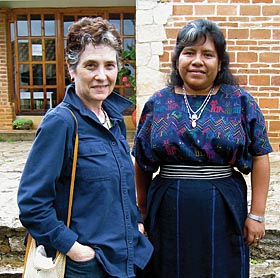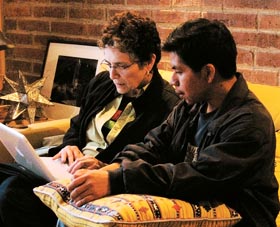On a planet that seems to be growing smaller by the day, it's surprising to discover that people still use approximately 6,500 languages for their day-to-day communication. But linguists estimate that nearly half of these will be gone within the next hundred years, an extinction rate equivalent to one language lost every two weeks.
Throughout history, language loss has been attributable to such human behaviors as war or to natural events like earthquakes or tsunamis. In recent decades, however, the erosion is driven more by economic and cultural pressures. "People are abandoning their native languages in favor of globally dominant tongues such as English, Spanish, Arabic, or Mandarin Chinese," notes UC Santa Cruz linguistics professor Judith Aissen.
"Parents around the world want their children to speak mainstream languages to give them an economic advantage," Aissen says. The result of this transformation: half of the world's population now speaks just 10 languages.
Aissen and other linguists liken the magnitude of this language loss to the decline of plant and animal species. "When a language dies, it takes with it a vast array of knowledge--the stories of plants and their medicinal uses, songs, history, art, culture, and the very identity of the people--which is embedded in their language," says Aissen. As a result, a concerted effort has been undertaken by experts in the past decade to document currently spoken languages and, where possible, reverse the trend.
Aissen's own research focus is on Tzotzil, a language spoken by about 250,000 people in Chiapas, the southernmost state of Mexico, and one of 30 Mayan languages still spoken in Mexico and Guatemala. Since 1995, she has made repeated trips to the area to teach indigenous Mayan speakers there how to analyze and help preserve their languages.
"I teach workshops in syntax to native speakers--undergraduates and grad students in linguistics-so they can do research on their own languages," Aissen says. "I'm giving them the analytical tools to play a leading role in the analysis and documentation of their languages. When you have people doing scientific work on a language, it has the effect of raising the importance of preserving it."
Aissen cites one student from these summer workshops--an indigenous Mayan speaker working toward a Ph.D. in linguistics at the University of Texas--who is going back to his community and digitally recording his native language. He is also employing assistants from the area and training them to help him. "When people in a community see documenting a language as a worthwhile thing to do, it reinforces the value of the language," notes Aissen. "It is viewed as a heritage worth passing on to their children, and this is essential if a language is to be saved from extinction."
Several Mayan languages are already extinct and others are highly endangered. While 250,000 remaining speakers of Tzotzil may seem like a large number, Aissen points out that preserving the language is a fragile balancing act, as more members of the community begin to learn Spanish and become bilingual. "The more roads that are built, the more access to education in Spanish, and the more TV sets that are broadcasting Spanish into households, all mean that there is less likelihood that the language will survive," says Aissen.
Aissen began studying Mayan languages in 1972 as a linguistics graduate student at Harvard where she participated in a long-term anthropology project sponsored by the National Science Foundation. She traveled to San Cristobal de las Casas, a colonial town in the highlands of Chiapas, where she conducted fieldwork with native speakers. After joining the UCSC faculty in 1983, Aissen continued to return to San Cristobal in the summers to carry out her own research. She eventually began teaching workshops under the auspices of research organizations in Mexico and Guatemala with the goal of helping to preserve the threatened Mayan languages.
But Aissen notes that saving endangered languages is more than the preservation of culture and historical traditions. It's also about exploring the connection between the grammars of different languages and learning more about the way in which the human brain processes language.
"Linguistics is the scientific study of language," says Aissen. "Linguists are interested in studying what the human capacity for language is; they want to understand the full range that humans can acquire. But a theory based on 5,000 languages will be much richer than one based on 50."
Or to cite an analogy from the plant world, it's the difference between a botanist having only a few different species to study in a flower shop, or assessing the amazing diversity of the Amazon rainforest.
"Languages that serve large numbers of people, such as English, become simplified because they have to serve the communication needs of so many people," adds Aissen. "Indigenous languages may actually be more complicated in grammatical structure, and that's a very compelling reason to document them. It's about preserving vital knowledge for future generations."




